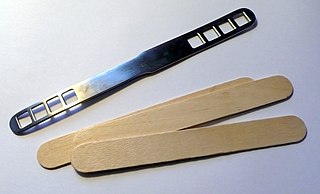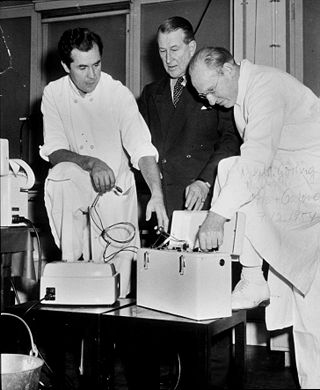Related Research Articles

An artificial cardiac pacemaker is a medical device, nowadays always implanted, that generates electrical pulses delivered by electrodes to one or more of the chambers of the heart, the upper atria or lower ventricles. Each pulse causes the targeted chamber(s) to contract and pump blood, thus regulating the function of the electrical conduction system of the heart.

Siemens AG is a German multinational technology conglomerate. Its operations encompass automation and digitalization in the process and manufacturing industries, intelligent infrastructure for buildings and distributed energy systems, rail transport solutions, as well as health technology and digital healthcare services. Siemens is the largest industrial manufacturing company in Europe, and holds the position of global market leader in industrial automation and industrial software.
Abbott Laboratories is an American multinational medical devices and health care company with headquarters in Abbott Park, Illinois, United States. The company was founded by Chicago physician Wallace Calvin Abbott in 1888 to formulate known drugs; today, it sells medical devices, diagnostics, branded generic medicines and nutritional products. It split off its research-based pharmaceuticals business into AbbVie in 2013.

Medtronic plc is an American medical device company. The company's operational and executive headquarters are in Minneapolis, Minnesota, and its legal headquarters are in Ireland due to its acquisition of Irish-based Covidien in 2015. While it primarily operates in the United States, it operates in more than 150 countries and employs over 90,000 people. It develops and manufactures healthcare technologies and therapies.

A medical device is any device intended to be used for medical purposes. Significant potential for hazards are inherent when using a device for medical purposes and thus medical devices must be proved safe and effective with reasonable assurance before regulating governments allow marketing of the device in their country. As a general rule, as the associated risk of the device increases the amount of testing required to establish safety and efficacy also increases. Further, as associated risk increases the potential benefit to the patient must also increase.
Guidant Corporation, part of Boston Scientific and Abbott Labs, designs and manufactures artificial cardiac pacemakers, implantable cardioverter-defibrillators, stents, and other cardiovascular medical products. Their company headquarters is located in Indianapolis, Indiana. Their main competitors are Medtronic, St. Jude Medical, and Johnson and Johnson.

Rune Elmqvist (1906–1996) developed the first implantable pacemaker in 1958, working under the direction of Åke Senning, senior physician and cardiac surgeon at the Karolinska University Hospital in Solna, Sweden.
St. Jude Medical, Inc. was an American global medical device company headquartered in Little Canada, Minnesota, U.S., a suburb of Saint Paul. The company had more than 20 principal operations and manufacturing facilities worldwide with products sold in more than 100 countries. Its major markets include the United States, Europe, Latin America and Asia-Pacific. The company was named after Jude the Apostle, the patron saint of lost causes.
Robert Fischell is a physicist, prolific inventor, and holder of more than 200 U.S. and foreign medical patents. His inventions have led to the creation of several biotechnology companies. He worked at the Johns Hopkins University Applied Physics Laboratory full-time for 25 years and part-time for an additional 13 years. He contributed to APL's satellite navigation work; he later developed a rechargeable implantable pacemaker that could be programmed with radiowaves,. He and his team at Hopkins also helped miniaturize the implantable cardiac defibrillator. Mr. Fischell went on to invent the implantable insulin pump, numerous coronary stents used to open clogged arteries, and two feedback systems that provide early warning of epileptic seizures (NeuroPace) and heart attacks. Fischell recently donated $30 million to the University of Maryland College Park Foundation to establish a bioengineering department and an institute for biomedical devices at the A. James Clark School of Engineering.

Alfred E. Mann, also known as Al Mann, was an American physicist, inventor, entrepreneur, and philanthropist.
Siemens Healthineers is a German company which provides healthcare solutions and services. It was spun off from its parent company Siemens in 2017, which retains a 75% stake. Siemens Healthineers is the parent company for several medical technology companies and is headquartered in Erlangen, Germany.
Automated insulin delivery systems are automated systems designed to assist people with insulin-requiring diabetes, by automatically adjusting insulin delivery in response to blood glucose levels. Currently available systems can only deliver a single hormone—insulin. Other systems currently in development aim to improve on current systems by adding one or more additional hormones that can be delivered as needed, providing something closer to the endocrine functionality of the pancreas.
Abiomed, Inc. is a medical device technology company that operates as a stand-alone business within Johnson & Johnson's MedTech Segment. Abiomed develops and manufactures temporary external and implantable mechanical circulatory support devices. The company is headquartered in Danvers, Massachusetts with additional offices in Woburn, Baltimore, Berlin, Aachen, and Tokyo.

Anthony J. Adducci was a pioneer of the medical device industry in Minnesota. He is best known for co-founding Cardiac Pacemakers, Inc., the company that manufactured the world's first lithium battery powered artificial pacemaker. The lithium-iodide cell revolutionized the medical industry and is now the standard cell for pacemakers.

A cyborg —a portmanteau of cybernetic and organism—is a being with both organic and biomechatronic body parts. The term was coined in 1960 by Manfred Clynes and Nathan S. Kline. In contrast to biorobots and androids, the term cyborg applies to a living organism that has restored function or enhanced abilities due to the integration of some artificial component or technology that relies on feedback.
Thoratec Corporation is a United States-based company that develops, manufactures, and markets proprietary medical devices used for mechanical circulatory support for the treatment of heart-failure patients worldwide. It is a global leader in mechanical circulatory support devices, particularly in ventricular assist devices (VADs).
Manny Villafaña, a child of Puerto Rican immigrants, he attended Cardinal Hayes High School in the Bronx. He began his medical career in 1964 at medical-device exporter Picker International. In 1967, he was hired away from Picker by Earl Bakken, CEO of Medtronic to become their first international sales administrator.
Barnaby Michael Douglas Jack was a New Zealand hacker, programmer and computer security expert. He was known for his presentation at the Black Hat computer security conference in 2010, during which he exploited two ATMs and made them dispense fake paper currency on the stage. Among his other most notable works were the exploitation of various medical devices, including pacemakers and insulin pumps.

Cardiac Pacemakers, Inc.(CPI), doing business as Guidant Cardiac Rhythm Management, manufactured implantable cardiac rhythm management devices, such as pacemakers and defibrillators. It sold microprocessor-controlled insulin pumps and equipment to regulate heart rhythm. It developed therapies to treat irregular heartbeat. The company was founded in 1971 and is based in St. Paul, Minnesota. Cardiac Pacemakers, Inc. is a subsidiary of Boston Scientific Corporation.
Cyborg data mining is the practice of collecting data produced by an implantable device that monitors bodily processes for commercial interests. As an android is a human-like robot, a cyborg, on the other hand, is an organism whose physiological functioning is aided by or dependent upon a mechanical/electronic device that relies on some sort of feedback.
References
- ↑ "The Alfred Mann Foundation," Archived 2007-02-18 at the Wayback Machine Mission and History
- ↑ Meadows, P., "Technology Transfer and Successful Electrical Stimulation Business," Archived 2007-09-27 at the Wayback Machine Advanced Bionics Corporation, p. 2.
- ↑ "Programmable Pacemaker," Spinoff (Publication of NASA featuring commercial applications of space technology), 1996. Accessed February 25, 2007.
- ↑ "St. Jude buys Siemens cardiac pacemaker business," Health Industry Today - August 1994, Accessed February 25, 2007.